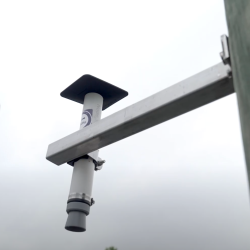Sumant Nigam Reappointed as Chair of UMD’s Department of Atmospheric and Oceanic Science for Five-year Term
Professor Sumant Nigam has been reappointed chair of the University of Maryland’s Department of Atmospheric and Oceanic Science (AOSC) for a five-year term, effective July 1, 2023. He has been chair for the last three years.
“I am grateful for Sumant's leadership and vision to ensure the Department of Atmospheric and Oceanic Science continues building a strong future for Earth sciences research and education here at Maryland,” said Amitabh Varshney, dean of UMD’s College of Computer, Mathematical, and Natural Sciences (CMNS).

Nigam, who joined UMD in 1987, will continue to lead the department, which has 16 tenured/tenure-track faculty members, 24 professional-track faculty members, over 100 students and annual research funding of nearly $9 million.
“I feel honored to have the support of the AOSC community and Dean Varshney on this reappointment,” said Nigam, who also holds a joint appointment in the university’s Earth System Science Interdisciplinary Center (ESSIC). “It is a privilege to lead a top-10-ranked department whose students and faculty pursue science that is intellectually and computationally challenging yet of great relevance for societal well-being and the health of our planet. I consider growing the department’s national and international eminence through academic rigor and research heft a sacred responsibility.”
Under Nigam’s leadership as chair, AOSC announced a partnership in October 2022 with the state of Maryland’s Department of Emergency Management to design, build and operate the Maryland Mesonet—a network of high-quality weather monitoring and data-collection towers across the state to advance emergency preparedness and the accuracy of regional weather forecasts. As many as 10 towers in the Maryland Mesonet will be operational by the end of 2023.
Nigam also hired new faculty members, including Assistant Professor Maria Molina, who works in the frontier area of machine learning in atmospheric and climate science, and Research Professor Louis Uccellini, who recently retired as director of the National Weather Service and brings expertise in the area of extreme weather. Nigam also appointed Alexandra Jones as the full-time director of the department’s undergraduate program to further develop the advising program and foster student success.
As chair, Nigam also reenergized the Maryland State Climatologist Office, which is housed in AOSC, through CMNS investments and AOSC resources. The office’s new staffing, data servers and climate data sets educate Marylanders on current and emerging climate trends, allowing them to place extreme events in a historical perspective. The monthly Maryland Climate Bulletin issued by State Climatologist Alfredo Ruiz-Barradas is critical to these efforts.
Last year, AOSC also received a UMD Grand Challenges Institutional Grant to Address Climate Challenges for a Sustainable Earth. The project, which will leverage the Maryland Mesonet, will characterize extreme weather vulnerabilities across the state to support regional policy and response preparation, help policymakers and farmers optimize agriculture productivity and sustainability in the face of climate change, and reimagine experiential education for students. AOSC faculty members co-lead the project with the faculty members from ESSIC; the Department of Geology; the Department of Geographical Sciences; and the Marine Estuarine and Environmental Science graduate program.
For the next five years, Nigam plans to ensure AOSC is at the center of climate and Earth system science teaching and research on campus, as well as a leader in developing weather and climate services for the state of Maryland and the nation.
“Being disciplinarily rooted and strong but multidisciplinarily flexed will position us well for the future,” he said.
In his personal research, Nigam uses observational analysis, theory and dynamical modeling to gain insights into the structure and mechanisms of midlatitude climate variability, ocean-atmosphere interactions, droughts and deserts, monsoon variability, and global warming.
He is currently working to unravel the natural variability and climate change components of the observational record to advance understanding of the steep warming of the northern continents, loss of Arctic sea ice, and the warming of West Antarctica. He also studies the evolution and hydroclimate impacts of the Atlantic Multidecadal Oscillation—a 50- to 70-year cyclical variation of North Atlantic sea surface temperatures.
Each spring, Nigam’s lab issues seasonal forecasts of the El Niño-Southern Oscillation—a recurring climate pattern involving changes in the temperature of waters in the central and eastern tropical Pacific Ocean—and the South Asian summer monsoon, with the latter informing India’s official monsoon forecast.
Nigam is a fellow of the American Meteorological Society and the Royal Meteorological Society. An active educator and mentor, Nigam has advised or co-advised 19 Ph.D. students, 13 M.S. students and numerous undergraduates.
Before being awarded a 2020 Fulbright-Nehru Fellowship, Nigam chaired the American Meteorological Society’s Committee on Climate Variability and Change (2014-18) and led the drafting of its 2019 Information Statement on Climate Change.
He has also served in multiple capacities to help the National Center for Atmospheric Research (NCAR) fulfill its mission. He has served on the NCAR Advisory Panel, chaired the advisory panel for NCAR’s Climate and Global Dynamics Laboratory (2015-18), and co-chaired the Climate Variability Working Group of NCAR’s Community Climate System Model (2005-09).
Nigam was a Jefferson Science Fellow at the National Academy of Sciences (2016-17) and previously served as a member of the Academy’s Board on Atmospheric Sciences and Climate (2011-12) and its Climate Research Committee (2008-10). He also served as director of the National Science Foundation’s Large-scale Dynamic Meteorology Program (2000-03).
Nigam earned his master’s degree in physics from the five-year integrated science and engineering program at the Indian Institute of Technology Kanpur in 1978, and his master’s and Ph.D. in geophysical fluid dynamics from Princeton University in 1981 and 1984, respectively. He joined UMD after a three-year postdoctoral fellowship at the Massachusetts Institute of Technology.







